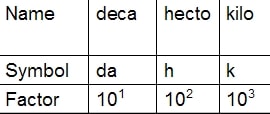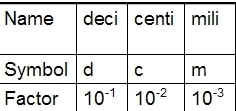Prefixes
Common SI Prefixes

The Meter
For example, notice the smallest unit on a ruler. That is the millimeter (mm).
The word millimeter is made from the base word “meter” and the prefix “milli-”. “Milli-” means “thousand”. So, a millimeter is equal to one thousandth of a meter.

Example: The Kilogram

Similarly, the word “kilogram” means “1,000” grams. Remember however that the kilogram is the base unit, not the gram.
The other prefixes and bases work similarly.
Memory Refresher:
“Milli-” + “gram” = milligram (much smaller than a gram)
“Kilo-” + “gram” = kilogram (much larger than a gram)
Calculating the Prefixes

To find the value of a prefix, lets look at the factor number.
Look at the exponent, or the smaller number above the 10. This number tells us how many times the 10 should be multiplied by itself.
For example, “Kilo-“:
10 x 10 x 10 = 1,000
Remember “kilo” means “1,000.”
The rest of the top chart works the same way.

The bottom chart works slightly differently. You may have noticed that the exponents have minus signs in front of them, indicating negative exponents. The negative exponents mean that these units are smaller than the base unit (e.g. meter, liter, etc.)
It works this way. To reach 1/1000th of the base unit, you can’t simply divide; the rule for a negative exponent are a bit different. You first have to place the number with the negative exponent into the bottom a fraction, remove the negative sign, and put the number 1 on the top of the fraction.
For example, mili-:
10-3 = 1/103
Then you can multiply the 10 by itself 3 times:
1/(10x10x10) = 1/1,000
“mili” means thousand just like “kilo” does, but in this case it means “one thousandth of a unit” or 1/1,000.
The rest of the bottom chart works the same way.
